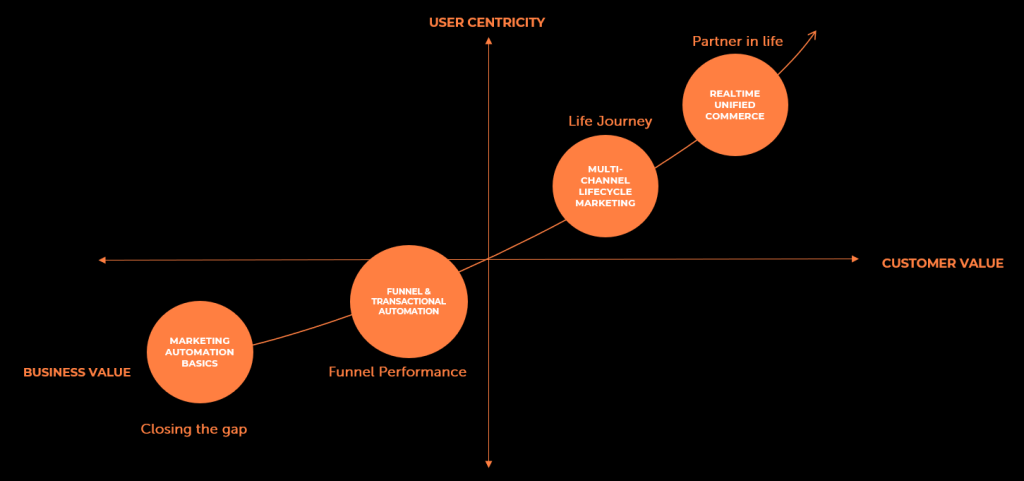Marketing automation: the secret sauce behind 2022 trends

Trends are moving fast and keeping up with changes in digital marketing is crucial. As the User Agency, following trends is the equivalent of caring for our users. As we always say: happy user grow successful businesses. The same goes for marketing automation. It’s a way to use technology to care for our users and build brand love and brand trust.
Now, if you’re a marketer, you might have an idea of what goes into this magical time-saving technique that helps build meaningful relationships.
But what exactly is marketing automation?
Is it software? Or is it, like one of our colleagues describes it, “lots of little Minions working in the background to gather and analyse data”? Yes and yes…but so much more. Let’s take a closer look at the power of marketing automation and how it’s closely linked to two of 2022’s biggest trends.
Anticipated. Personal. Relevant.
Simply put, marketing automation makes the lives of a marketer and business super easy. You guessed it, it automates repetitive tasks to manage marketing processes and campaigns. More importantly it’s the enabler of what advertisers aim to do: sending the right message at the right moment in the right channel. It helps you to speak to a single user in a personal, seamless manner and add value to their experience.
Marketing automation also gives birth to the growth of a personal relationship between a user and a brand. By growing, we mean removing any frictions and creating transactional convenience. It’s about ensuring that the basics are in place, before moving onto a 360° multi-channel journey and, finally, taking the relationship to the next level to become a ‘partner in life’.
Marketing automation is everywhere, from behavioural tracking and targeting on social media, to informing a 360-degree user journey. It can feed loyalty programmes with the right data insights or segmentation, enable push notifications in an engagement model, or work with AI to supercharge data insights and predict business growth.
Roadmap towards a frictionless user journey
When we consult brands on a marketing automation journey, it is important to have a clear roadmap. We use the grid below to audit a client and see where they are currently sitting in their marketing automation journey. We then plan tactics together to grow the brand toward the next level.
In the short term, depending on a brand’s maturity, this might mean adding more transactional convenience and getting the basics of marketing automation right. In the long-term, we work towards a frictionless 360-degree journey to become a ‘partner in life’.
Now that you know more about marketing automation, let’s see how it supports two hot 2022 digital trends.

Trend #1: Zero tolerance for digital inconvenience
If there is one thing the pandemic cemented is that ultra-convenient services have become the norm. When we were locked down in our homes with nowhere to go but online, we started to lose patience with brands that offer slow and frustrating experiences. We became accustomed to the ‘frictionless journeys’ offered by the best brands in the market. No matter what sector you’re in, the benchmark for user-friendly technology is no longer your direct competitor, but the interfaces of Amazon, Netflix and Uber have become.
The pandemic was, in fact, the best ever digital training model, forcing brands to adopt high digital performance is the new norm. From now on, there is a renewed focus on user experience – one that is zero effort, hyper-personalised, frictionless and pro-active. Where interfaces are almost invisible.
Take Amazon Go stores. This cashierless shop removed every single possible friction: you simply walk into a store, scan your phone and pop anything you need into your handbag. Or Lufthansa’s biometric boarding, where kiosks armed with facial recognition technology can speed up total boarding time by 50%. Trialled at LAX airport, one kiosk could identify passengers, crosscheck them in the Customs and Border Protection database and board them on a plane within minutes.
Sounds idyllic? Of course, there are lots of steps and actions happening in the background – smart cameras that track you, apps on your phone, unique QR codes, sophisticated facial recognition, etc. Many of these steps are made possible by marketing automation. For example, registration data is collected, processed and categorised to be used at just the right time. Say, when a couple is done shopping at Amazon Go, they will receive a menu idea for two for their upcoming anniversary, based on what they bought. Travellers might get suggestions on sights or restaurants to visit at their destination.
Marketing automation can support you in the entire journey from acquisition and engagement to the experience and post-experience. There will be less of some elements and more of others. Less logging in twice, less spammy emails, less clicks when buying online. Smoother registration with an identified history and a better 1:1 relationship tailored to your behaviour.
Trend #2: Partner in life
When the basics are in place, the journey doesn’t stop after making a purchase. This is when we take things from ‘selling relationship’ and to becoming what we call ‘a partner in life’ – where long-term brand loyalty is fostered.
Two examples spring to mind. Firstly, take Lumi by Pampers. This clever little Sleep Sensor tracker helps new parents monitor their baby’s sleep 24/7. Syncing to a camera and app, it gives them all the information they need from a ‘smart nappy’. It helps them build healthy sleep routines, gives them personalised sleep and development insights and advice. With special offers on Lumi by Pampers nappies, the brand also creates a bridge to the business side of things. In short, Lumi has become a partner in life for these parents – there for them when they need it most.
The second love brand is Samsung’s Family Hub. It has a myriad features that makes it a companion in your home, from a built-in camera that can check if you’ve run out of milk, to staying connected to your family and home, controlling other Samsung smart appliances and devices, streaming music, sharing pictures with your family, and much more. It can track expiration dates on food items, help manage diets…the list goes on. The bigger picture: less wasted food, savings on groceries, alerts if it needs maintenance and a more organised family life.
Behind the scenes, marketing automation supports this journey – e.g. enabling the right push message from the app from the right trigger. It is easy to see how the company is building a lifelong link between an appliance and your entire life, making Samsung a much-adored love brand.
How to build long-term brand love
Want to be considered a partner in life by users? Here are some steps to follow:
1. Data science
Start analysing your audience and first party data to look for insights on tendencies and trends. In the case of Nike Adventure Club, the insight that sparked a new service was that children outgrow their shoes very fast, needing a new pair every six months. Also, that kids can’t always articulate what they want in store. Trying shoes on at home, with a wide choice of options, removes a friction point for parents who are often shopping on their behalf.
2. Co-creation
Work with users directly to build a next level product or service that would make their lives easier. Ask them: how can our brand help them in their daily lives? With roundtable discussions with loyal users, see how you can create a partner in life service that will benefit everyone.
3. Offer privileges
Build value for your most loyal customers by offering them early/exclusive access to a product or service. This sense of exclusivity is an engaging way to build a partner relationship with your users.
4. Activations
They are many possibilities for activation campaigns – especially if the execution is original and memorable. Invite segments of your audience to try your product in person and you will start being seen as a partner in life brand.
5. Reward ambassadorship
People who advocate your brand are your most precious fans and should be treated like gold. Think beyond tiers and point-based programs and make your rewards meaningful, like Nike Adventure Club used to do with its ambassadors subscription model.
The bottom line…
Zero tolerance for inconvenience is here to stay, and marketing automation can help to get the basics right. What’s more, marketing automation can assist you in building better user relationships by constantly tailoring and exceeding their experiences. People love brands that care; brands that communicate in a personal way.
Want to be a love brand? Want to turn your customers into lifelong fans? Then get in touch with our marketing automation experts today.




